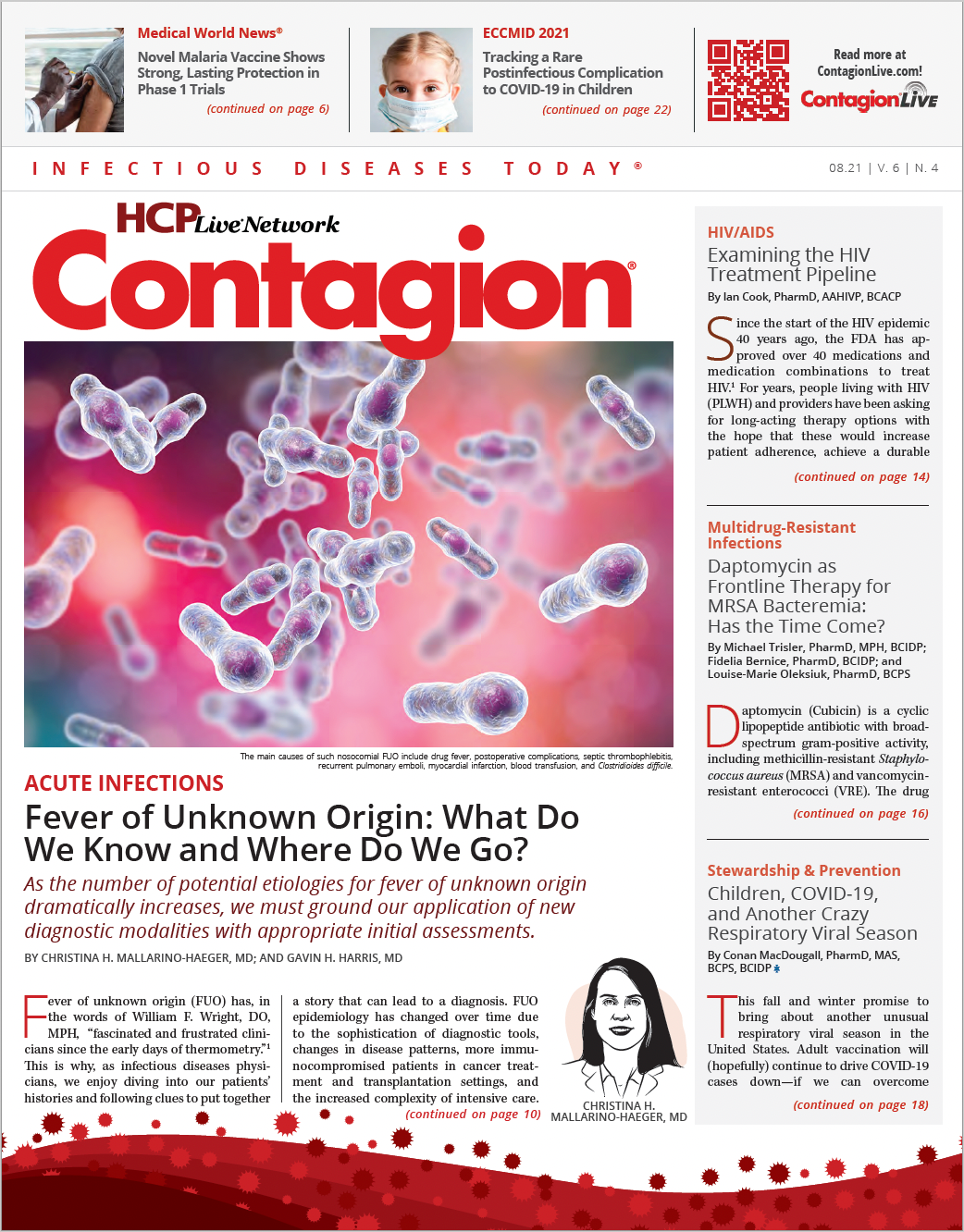Paradigm Shift in the Management of Clostridioides difficile Infections
The Contagion expert panel

Management of Clostridium difficile infection (CDI) has shifted toward more targeted, microbiome-sparing approaches to decrease recurrence and improve clinical outcomes. Demonstrating the return on investment will be important to increase the uptake of these new, more expensive agents, according to panelists who participated in a Contagion® Peer Exchange panel moderated by Peter L. Salgo, MD.
C difficile: Updates to Clinical Practice Guidelines
Thomas Lodise, PharmD, PhD, noted that an update to the Infectious Diseases Society of America/Society for Healthcare Epidemiology of America (IDSA/SHEA) guidelines prioritized fidaxomicin as the primary agent recommended for patients with initial and recurrent episodes of CDI. The update was based on data showing lower rates of recurrence with fidaxomicin than with vancomycin, including from the initial phase 3 trial (NCT00314951)1 in patients with clinically diagnosed CDI (initial or recurrent) and the phase 3b/4 EXTEND trial (NCT02254967) that used an extended-pulsed fidaxomicin in hospitalized patients 60 years or older.2 The update was delivered as provisional recommendations at IDWeek 2020.
“Fidaxomicin seems to come to the forefront for treatments with the initial episode,” said Joseph Reilly, PharmD. “When fidaxomicin came out, I don’t think many people were familiar with the term ‘sustained clinical response.’ That seems to be the advantage of using [fidaxomicin] in many patients, that they are less likely to have recurrences.”
Lodise added that the provisional IDSA/SHEA recommendations included an additional recommendation for bezlotoxumab, a human monoclonal antibody that targets toxin B, in individuals who are at high risk for recurrence, aged 65 or older, are immunosuppressed, have a history of CDI, or have severe CDI. The MODIFY I and MODIFY II trials (NCT01241552 and NCT01513239) showed that bezlotoxumab was associated with lower rates of recurrence in multiple prespecified subgroups, including patients who were 65 years or older, had immunocompromised status or severe CDI, or who had had a CDI episode within the past 6 months.3
Selecting Therapy to Treat C difficile
Adequate treatment of CDI is particularly challenging because it requires eradicating the C difficile organism while attempting to restore the microbiota, according to Paul Feuerstadt, MD. He added that optimally effective treatment involves antimicrobial therapy (such as vancomycin or fidaxomicin) followed by modulation of the immune system with bezlotoxumab or microbiota restoration therapy to “give C difficile that knockout punch.
Most patients who receive either fidaxomicin or vancomycin will respond and will get better,” said Feuerstadt. “What we’re talking about with other therapies are those subgroups that are at greater risk: age over 65, history of immune suppression, history of C difficile, the NAP1/B1/027 strain, severe infection, patients on PPIs [proton pump inhibitors], [and] patients who received concomitant antimicrobials. Those are the individuals that we’re really focusing on [to gain a] better understanding of how we get rid of this.”
Feuerstadt added that the “entire clinical gestalt” of a patient should be considered in the approach to therapy; factors that may affect management decisions include source of infection (community or health care setting) and presence of multiple risk factors for recurrence, severe disease, and high white blood cell count and creatinine.
“Deciding between vancomycin and fidaxomicin to me really boiled down to those factors and risk factors for recurrence,” said Feuerstadt. “Fidaxomicin’s sweet spot is that it is associated with statistically significant reduction in rates of recurrence. Patients who have multiple high-risk factors for recurrence would benefit from that product.”
C difficile Treatment: Fidaxomicin
Fidaxomicin is a macrolide-like antibiotic that inhibits RNA synthesis by binding to bacterial RNA polymerase4 and has potent activity against CDI, according to Lodise. He added that the more targeted approach, less disruption of the gut microbiota, and lower minimum inhibitory concentration with fidaxomicin likely contribute to the lower rates of recurrence compared with vancomycin. “It’s that prolonged disruption of the microbiota [with vancomycin] that drives a lot of the adverse outcomes we see in some of our CDI patients,” he said.
“When we think about treating CDI from a stewardship standpoint, our thought [is], ‘How do we stop that event from moving forward?’ Although we appreciate the similar clinical response, we were very impressed with a lot of the lower recurrence data and particularly with some of the altered dosing with fidaxomicin in one of their 2 trials.”
Lodise noted that the tapered and pulsed regimen of fidaxomicin may be beneficial for treating a recurrent episode while facilitating recovery of the microbiota, but that developing additional methods to replenish the microbiota will be important moving forward.
Reilly noted that although the data appear to support the use of fidaxomicin in the first-line setting, the high acquisition cost of the drug relative to vancomycin remains a concern. However, he and Salgo agreed that using the more expensive fidaxomicin could reduce overall costs of care in the long run and improve patient outcomes by reducing readmission rates and other comorbidities.
“It’s that silo budget mentality, just looking at how much we’re spending and not looking at the outcomes,” said Reilly. “If I spend more money and it’s saved somewhere else by decreasing admissions that might lose money…people often don’t take that into consideration.”
Teena Chopra, MD, MPH, said that patient-centered outcome research could help demonstrate the overall improvement in clinical outcomes and cost savings with fidaxomicin. Chopra and her colleagues performed an analysis of a patient discharge database that showed that the 30-day readmission rate was higher for patients with CDI than those without CDI (30.1% vs 14.4%).5 In addition, results from a single-center retrospective study demonstrated that, on average, treatment with fidaxomicin saved the hospital $3207 per patient compared with vancomycin treatment (even though the drug costs were higher with fidaxomicin), largely attributable to the lower readmission costs associated with fidaxomicin.6
Lodise noted that the financial penalties associated with high rates of CDI and readmission and the escalating costs associated with multiple recurrences should encourage the shift toward fidaxomicin. He added that the 2020 IDSA/SHEA provisional recommendations were an important step forward in the acknowledgment of return on investment by including the number needed to treat.
“I think we need to stop talking about drugs in terms of dollars and cents, which we’re never going to get away from, and rather say, ‘If I do this, these are the adverse events I’m going to prevent,’” said Lodise. “We must change the script a bit. Cost is always going to be the common denominator, but we need to talk about how, with this investment, this is going to be [the] return, and we must make that return in terms of dollars and cents as well.”
Choosing Between Vancomycin and Fidaxomicin for C difficile Infections
Feuerstadt highlighted the fact that the lower recurrence rates observed in multiple trials comparing fidaxomicin with vancomycin were also observed in real-world data from the United Kingdom.7 This study, which assessed recurrence rates in the year before and after local introduction of fidaxomicin in 7 UK hospitals, showed that 2 hospitals that used fidaxomicin in the first-line setting for all primary and recurrent infections had a decrease in recurrence rate (10.6% to 3.1% and 16.3% to 3.1% for hospitals “A” and “B,” respectively).7 Feuerstadt noted that even the hospital that used fidaxomicin only for first recurrences (hospital “D”) had a decrease in recurrence rate (12.5% vs 21.1%, prior to fidaxomicin), suggesting that the real-world data reflect the results observed in phase 3 clinical trials.7
“What we’re seeing is no matter how fidaxomicin is being used, if a health care system commits to it, it seems to remarkably reduce those rates of recurrence,” concluded Feuerstadt.
References
- Louie TJ, Miller MA, Mullane KM, et al; OPT-80-003 Clinical Study Group. Fidaxomicin versus vancomycin for Clostridium difficile infection. N Engl J Med. 2011;364(5):422-431. doi:10.1056/NEJMoa0910812
- Guery B, Menichetti F, Anttila VJ, et al; EXTEND Clinical Study Group. Extended-pulsed fidaxomicin versus vancomycin for Clostridium difficile infection in patients 60 years and older (EXTEND): a randomised, controlled, open-label, phase 3b/4 trial. Lancet Infect Dis. 2018;18(3):296-307. doi:10.1016/S1473-3099(17)30751-X
- Wilcox MH, Gerding DN, Poxton IR, et al; MODIFY I and MODIFY II Investigators. Bezlotoxumab for prevention of recurrent Clostridium difficile infection. N Engl J Med. 2017;376(4):305-317. doi:10.1056/NEJMoa1602615
- Dificid. Prescribing information. Merck & Co, Inc; 2020. Accessed June 18, 2021. https://www.accessdata.fda.gov/drugsatfda_docs/label/2020/213138lbl.pdf
- Chopra T, Neelakanta A, Dombecki C, et al. Burden of Clostridium difficile infection on hospital readmissions and its potential impact under the Hospital Readmission Reduction Program. Am J Infect Control. 2015;43(4):314-317. doi:10.1016/j.ajic.2014.11.004
- Gallagher JC, Reilly JP, Navalkele B, Downham G, Haynes K, Trivedi M. Clinical and economic benefits of fidaxomicin compared to vancomycin for Clostridium difficile infection. Antimicrob Agents Chemother. 2015;59(11):7007-7010. doi:10.1128/AAC.00939-15
- Goldenberg SD, Brown S, Edwards L, et al. The impact of the introduction of fidaxomicin on the management of Clostridium difficile infection in seven NHS secondary care hospitals in England: a series of local service evaluations. Eur J Clin Microbiol Infect Dis. 2016;35(2):251-259. doi:10.1007/s10096-015-2538-z

